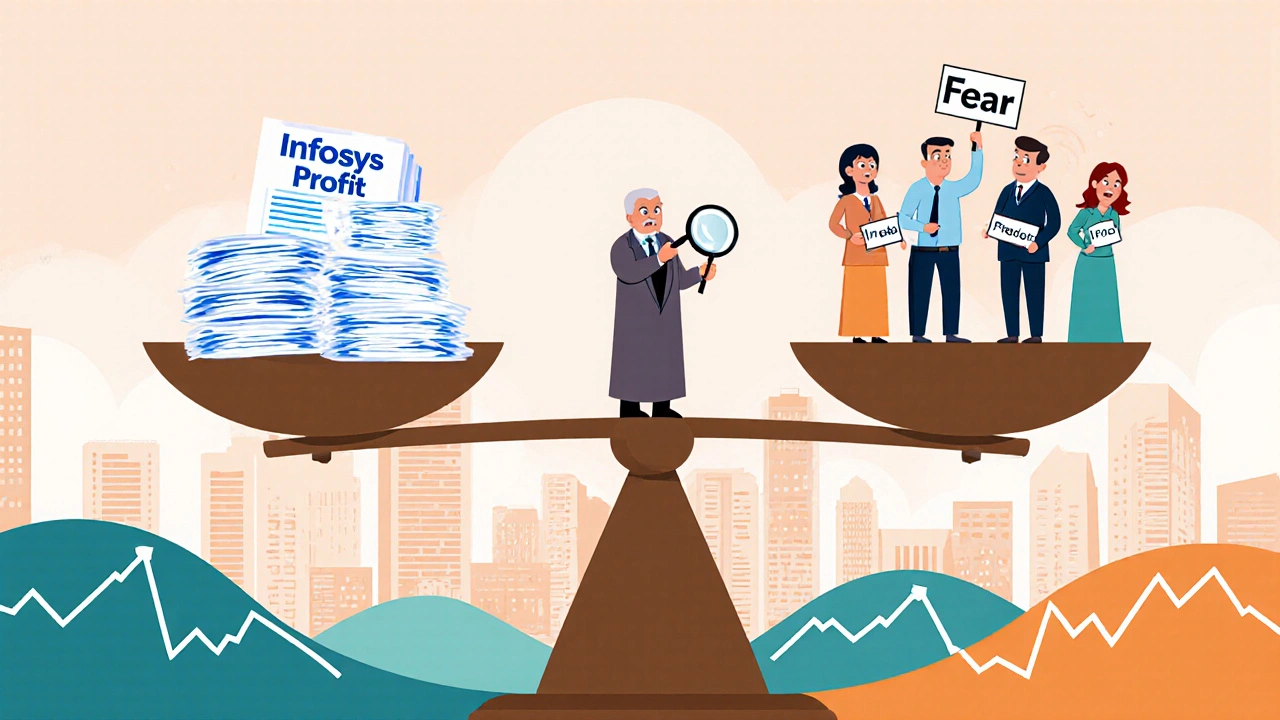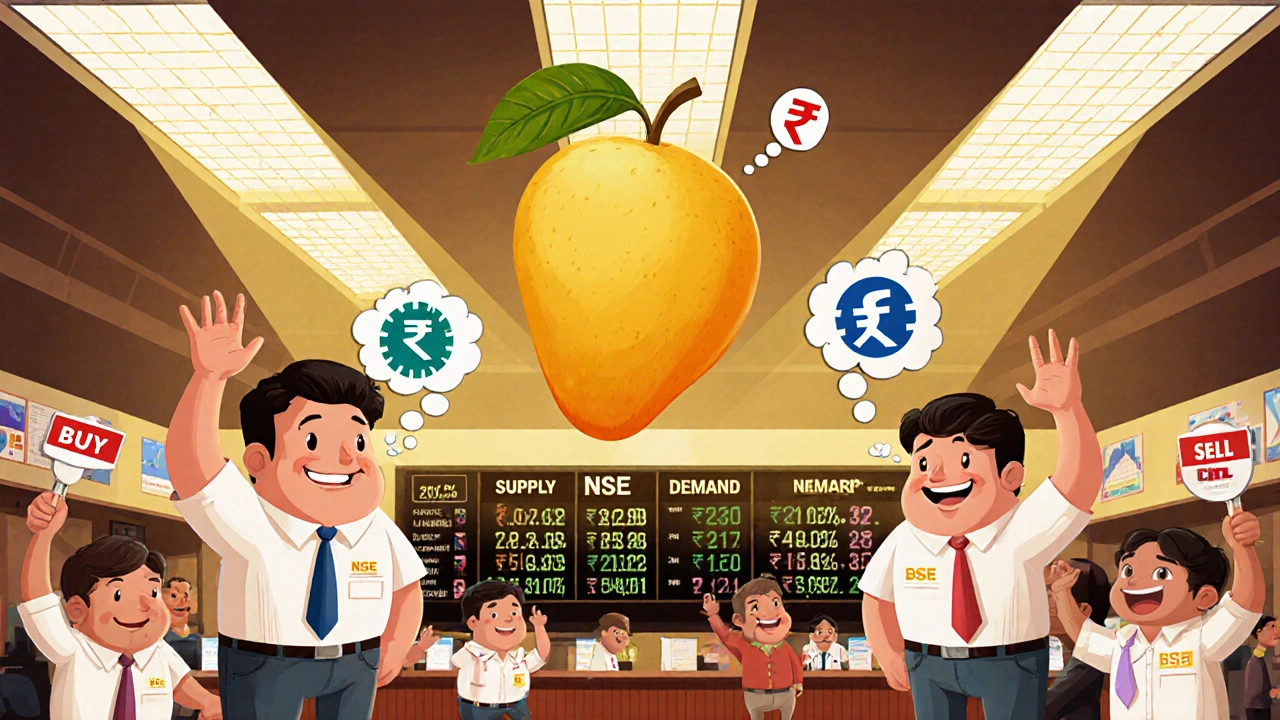Understanding Stock Prices in India: How Share Prices Are Determined
Ever wonder why one stock in India jumps 10% in a day while another drops 5% with no news? It’s not magic. It’s not rumor. It’s supply and demand-plain and simple-but with layers that most beginners never see. If you’ve ever bought a share in Tata Steel or Reliance Industries and then watched it swing without understanding why, you’re not alone. The Indian stock market isn’t just a place to buy and sell. It’s a living, breathing system shaped by real money, real people, and real events. Let’s break down exactly how stock prices are determined in India.
What Is a Stock Price, Really?
A stock price is the amount someone is willing to pay right now for one share of a company. It’s not the company’s value. It’s not its profit. It’s not its assets. It’s the price at which the last trade happened between a buyer and a seller. Think of it like an auction at a local market. If ten people want a mango and only five are available, the price goes up. If nobody wants it, the seller lowers the price. Stocks work the same way.
In India, this auction happens on exchanges like the National Stock Exchange (NSE) and the Bombay Stock Exchange (BSE). Every second, orders pour in-buy orders and sell orders. The system matches them automatically. The price moves based on who’s willing to pay more or accept less.
Supply and Demand: The Core Engine
At the heart of every stock price is supply and demand. But in India, this isn’t just about how many people want to buy. It’s about who’s buying, how much they’re buying, and when.
Let’s say Infosys reports better-than-expected quarterly earnings. Investors see it as a sign the company is growing. More people want to buy its shares. Sellers hold back, hoping to get a higher price. The result? Demand rises, supply stays flat, and the price climbs.
Now flip it. If a major Indian bank like HDFC gets hit with a regulatory fine, investors worry about future profits. Sellers rush to get out. Buyers pull back. Supply spikes, demand drops. Price falls.
This isn’t theoretical. In 2024, when Zomato posted its first annual profit, its share price jumped over 25% in two days. Why? Because for the first time, enough investors believed the business model could sustain itself. Demand surged. Supply didn’t keep up.
Company Performance: The Foundation
Stock prices don’t float in the air. They’re anchored, however loosely, to what a company actually does. In India, investors track key numbers like revenue growth, net profit, EBITDA margins, and return on equity (ROE). These aren’t just buzzwords-they’re signals.
For example, if a small-cap company like Polycab India consistently grows its revenue by 15% year after year and keeps its debt low, investors see stability. That drives long-term buying. On the other hand, if a company like Jet Airways had kept burning cash with no path to profitability, no amount of hype could keep its stock up.
Indian investors pay close attention to quarterly results announced by companies listed on the BSE and NSE. These reports are public. They’re scrutinized. And they move prices-fast.

Market Sentiment: The Emotional Wildcard
Here’s where things get messy. Sometimes, stock prices move not because of facts, but because of fear or excitement. In India, this happens often.
During the 2020 pandemic crash, Indian markets dropped 35% in weeks-not because companies suddenly became worthless, but because investors panicked. They sold everything, fearing lockdowns would kill profits. The same thing happened in early 2022 when global inflation spiked. Foreign investors pulled billions out of Indian equities, not because Indian companies failed, but because they feared rising U.S. interest rates.
News headlines, social media trends, and even political rumors can trigger these swings. A tweet from a senior minister about a new infrastructure plan can send construction stocks soaring. A rumor about a tax change on dividends can trigger a sell-off across banking stocks.
That’s why smart investors in India don’t just look at financials. They watch sentiment indicators like the VIX India (Volatility Index), which measures fear in the market. When it spikes above 25, it’s often a sign of panic. When it drops below 12, it’s often overconfidence.
Macroeconomic Factors: The Bigger Picture
Stock prices in India don’t exist in a bubble. They’re pulled and pushed by the country’s overall economic health.
Interest rates set by the Reserve Bank of India (RBI) matter a lot. When the RBI hikes rates to control inflation, borrowing gets expensive. Companies pay more for loans. Consumers spend less. Profits shrink. Stock prices tend to fall. When rates drop, the opposite happens.
Foreign investment is another huge factor. When global funds like FPIs (Foreign Portfolio Investors) pour money into Indian stocks, prices rise. In 2023, FPIs invested over $30 billion in Indian equities. That helped push the Nifty 50 to record highs. But in 2024, when the U.S. Federal Reserve kept rates high, those same investors pulled back. Indian markets dipped.
Currency matters too. If the Indian rupee weakens against the dollar, import-heavy companies like oil firms (Reliance, BPCL) see their costs rise. Their profits shrink. Their stock prices drop. Exporters like Tata Motors or Infosys benefit. Their stocks go up.
Market Structure: How the System Works
India’s stock market is one of the most digitized in the world. Over 150 million demat accounts are active. Retail investors now make up nearly 60% of trading volume on the NSE. That’s a big change from 10 years ago, when institutions dominated.
This shift has changed how prices move. Retail investors often trade based on tips, YouTube videos, or trending tickers on platforms like Zerodha or Groww. That creates short-term noise. But over time, fundamentals still win.
Order books on the NSE and BSE show real-time buy and sell orders. The best bid (highest price someone will pay) and the best ask (lowest price someone will sell for) create the current market price. The gap between them is called the bid-ask spread. In large-cap stocks like HDFC Bank, it’s often just a few paise. In small-cap stocks, it can be 5% or more. That’s why liquidity matters.
What Moves Prices in the Short Term vs. Long Term
Short-term price moves? News, rumors, sentiment, technical charts, algorithmic trading. A single tweet from a finance influencer can move a small-cap stock 15% in an hour.
Long-term price moves? Earnings growth, competitive advantage, management quality, industry trends. A company like Asian Paints has gone up 50x in 20 years-not because of headlines, but because it kept growing its market share, improving margins, and reinvesting profits.
Most beginners get fooled by the short-term noise. They buy when everyone’s excited. They sell when panic hits. The real winners in India’s market are the ones who ignore the daily swings and focus on what the business is actually doing.
How to Use This Knowledge
You don’t need to predict the market. You need to understand what drives it.
- Check a company’s quarterly results before buying. Look at revenue and profit trends-not just the headline number.
- Watch the RBI’s policy announcements. Rate changes ripple through the entire market.
- Track FPI inflows and outflows. They’re a strong indicator of global confidence in India.
- Avoid chasing hot tips. If a stock jumps 20% in a day with no news, it’s often a trap.
- Use tools like Screener.in or Moneycontrol to compare companies side by side. Look at P/E ratios, debt levels, and ROE.
Stock prices in India aren’t random. They’re the result of millions of decisions every day. Some are smart. Some are emotional. Some are based on data. Some are based on fear. The more you understand the forces behind them, the less likely you are to get swept away by the noise.
What is the main factor that determines stock prices in India?
The main factor is supply and demand. When more people want to buy a stock than sell it, the price goes up. When more people want to sell than buy, the price drops. This happens in real time on exchanges like the NSE and BSE. Company performance, investor sentiment, and macroeconomic factors all influence this balance, but the final price is always set by the last trade between a buyer and seller.
Do company profits directly affect stock prices in India?
Yes, but not immediately or always. Strong, consistent profits over time build investor confidence, which leads to higher demand for shares. However, a single quarter of good earnings might not move the price if the market expected even better results. Conversely, a company with low profits can still see its stock rise if investors believe it will turn around soon. Long-term price trends are strongly tied to profitability, but short-term moves can be driven by other factors like news or speculation.
How do interest rates in India impact stock prices?
When the Reserve Bank of India raises interest rates, borrowing becomes more expensive for companies and consumers. This can reduce spending and slow down business growth, which lowers expected profits. As a result, stock prices often fall. When rates are cut, borrowing gets cheaper, spending increases, and companies tend to grow faster. That usually pushes stock prices higher. Rate changes are one of the most powerful macroeconomic drivers in the Indian market.
Why do small-cap stocks in India swing more than large-cap stocks?
Small-cap stocks have fewer shares available for trading and less investor interest. That means even a small number of buy or sell orders can move the price dramatically. Large-cap stocks like Reliance or HDFC Bank have millions of shares traded daily. Their prices move slowly because there’s always a deep pool of buyers and sellers. Small-caps are more vulnerable to rumors, emotional trading, and low liquidity.
Can foreign investment really change Indian stock prices?
Absolutely. Foreign Portfolio Investors (FPIs) control billions of dollars flowing into Indian markets. When they buy, prices rise. When they sell, prices fall. In 2023, FPIs invested over $30 billion in Indian equities, helping push the Nifty 50 to record highs. In early 2024, when global markets tightened, FPIs pulled out billions, and Indian markets dipped. Their actions are a key barometer of global confidence in India’s economy.
What Comes Next?
Now that you know how prices are set, don’t try to guess the next move. Instead, start observing. Track a few companies you’re interested in. Watch how their prices react to earnings reports. Notice how the market responds when the RBI announces a rate change. Pay attention to whether foreign investors are buying or selling.
Over time, patterns emerge. You’ll start to see the difference between noise and signal. And that’s the real edge-not knowing what will happen next, but understanding why it happens when it does.





